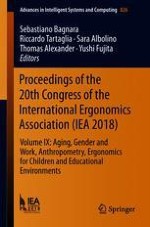2019 | OriginalPaper | Chapter
Assessment of Dimensional Needs for Designing Spaces for Wheelchair Users
Authors : Adrián Leal-Pérez, Libertad Rizo-Corona, John Rey-Galindo, Carlos Aceves-González, Elvia González-Muñoz
Published in: Proceedings of the 20th Congress of the International Ergonomics Association (IEA 2018)
Publisher: Springer International Publishing
Activate our intelligent search to find suitable subject content or patents.
Select sections of text to find matching patents with Artificial Intelligence. powered by
Select sections of text to find additional relevant content using AI-assisted search. powered by
